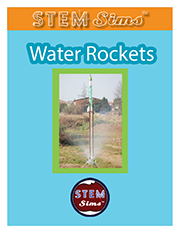Here are some definitions to help you in your investigation.
Motion - tells how something changes its position over time
Angle - the amount of turn of something
Degrees - a measure of the size of an angle
0 degrees - flat along the ground
90 degrees - straight up from the ground
Launch - to send off or release something
Distance - how far something moves
Meters - a unit that measures length or distance moved
Cause - something that brings about an action
Effect - a change as a result of an action
Force - a push or pull on something
Friction - a force that opposes the motion of something
Air resistance - friction due to something colliding with air particles
Energy - the ability to do work
Kinetic energy - energy due to the motion of something
Fluid - something that flows freely; a liquid or a gas
Property - a characteristic of something used to identify
Quantity - the amount of something
Mass - the amount of matter in something
Volume - the amount of space taken up by something
Density - a measure of the compactness of something
Viscosity - a measure of how easily a fluid flows
Reading and Interpreting a Line Graph
What is a Line Graph?
A line graph is a tool that provides a picture using a line or lines to show how things change over time or how they're connected. For instance, you want to see how a plant grows over time. So you measure the plant's height every week. You can use a line graph to see how the plant is growing!
Reading and Interpreting the Graph (See Figure 1.)
• Seeing Changes: Look at the line. If it goes up, the plant is growing! If it stays flat, it's not changing its height, and if the line goes down, the plant is losing height.
• Comparing Weeks: You can easily see which weeks the plant grew the most by looking for the steepest parts of the line.
Finding the Height (See Figure 2.)
• To find the plant height at a certain week, find that Week Number on the bottom line (x-axis), go straight up to the line, and then look across to the Plant Height number on the side (y-axis). On this graph, the plant at week 6 had a height of 9 centimeters.
Extrapolating the Data Beyond the Line (See Figure 3.)
• Following the Trend: If the line is going up or down steadily, you can predict that the plant will continue changing its height at about the same rate in the next few weeks.
• Making a Prediction: You can extend the line a little bit past your last data point (see the dashed line) to make a prediction about the plant's height in the future. But remember, it's just a prediction! Things might change.
Using our extended line in this graph, we predict the plant will have a height of 7 centimeters at week 11.
• Limitations: Extrapolating too far out is not always accurate. The plant could stop growing, or grow at a different rate.
)
What is pressure?
Pressure is defined as the force per unit area. For a given area, pressure increases with increasing force. For a given force, pressure decreases with increasing area. For example, a 5-pound book resting on a person's arm would not be too painful or cause much damage; however, if the same book was placed on the arm with a needle between the book and the arm, the increase in pressure due to the reduction in area would cause the person much pain.
What is Newton's Third Law of Motion?
Newton's third law of motion states that for any applied force on an object, the object applies an equal, but opposite force. The main idea about this law is that forces always come in pairs. Any application of force on something results in the something pushing back with an equal force. For instance, a bird flies by using wings to push down on air. The air pushes back upward on the bird's wing and allows the bird to stay aloft.
How do rockets fly?
Rockets use the principles of Newton's third law to fly. A rocket engine expels hot gases out of the rear of the rocket. As the particles of gas are pushed backwards out of the engine, the particles push back on the rocket in the opposite direction with the same force as they were expelled. This forward push propels the rocket in the forward direction. The hot gases are not pushing on air particles to propel the rocket forward. If this was happening, rockets could not fly in outer space where no air exists.
What is drag and how does it affect flight?
Drag is the opposition to the motion of an object caused by resistance due to air. A moving car encounters drag, which acts to slow down the car. As the speed of an object increases, the amount of drag on the object also increases. The size and shape of an object can also affect the amount of drag experienced by the object as it moves through air. Since space is nearly void of air, no drag exists in space to slow vehicles down.
What is a tradeoff?
Tradeoffs involve having to give up one thing in order to gain something else. The following is a good example of a tradeoff. Latiff has a collection of stunning pictures that she wants to immediately share with her friend, Peter, who lives on the other side of the country. Latiff's current computer system cannot handle her images at the high resolution. The only way to quickly send Peter her images are to compress them, which lowers their quality. Latiff must make a tradeoff between high image quality and speed of delivery.
 Water rockets work on the principle of Newton’s Third Law of Motion. Water and air are pushed out one end of the rocket, which provides a force in the opposite direction to propel the rocket forward. But what is the best amount of water to make a rocket travel the furthest? We hope that you are ready to get pumped up and find out.
Water rockets work on the principle of Newton’s Third Law of Motion. Water and air are pushed out one end of the rocket, which provides a force in the opposite direction to propel the rocket forward. But what is the best amount of water to make a rocket travel the furthest? We hope that you are ready to get pumped up and find out.)


